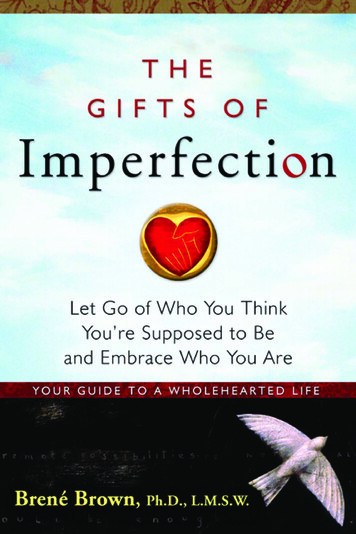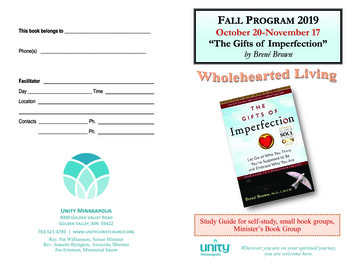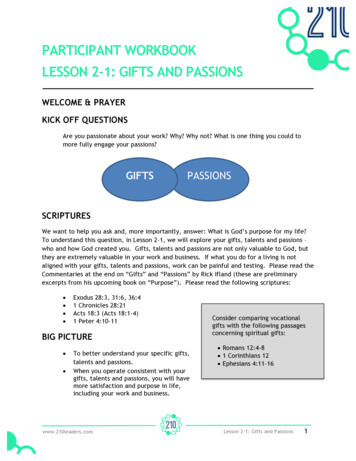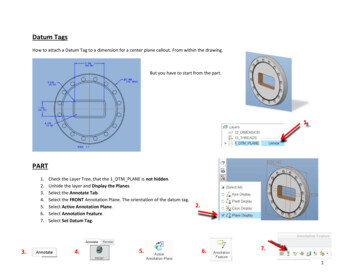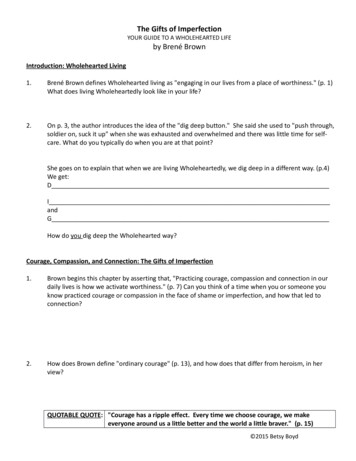
Transcription
The Gifts of ImperfectionYOUR GUIDE TO A WHOLEHEARTED LIFEby Brené BrownIntroduction: Wholehearted Living1.Brené Brown defines Wholehearted living as "engaging in our lives from a place of worthiness." (p. 1)What does living Wholeheartedly look like in your life?2.On p. 3, the author introduces the idea of the "dig deep button." She said she used to "push through,soldier on, suck it up" when she was exhausted and overwhelmed and there was little time for selfcare. What do you typically do when you are at that point?She goes on to explain that when we are living Wholeheartedly, we dig deep in a different way. (p.4)We get:DIandGHow do you dig deep the Wholehearted way?Courage, Compassion, and Connection: The Gifts of Imperfection1.Brown begins this chapter by asserting that, "Practicing courage, compassion and connection in ourdaily lives is how we activate worthiness." (p. 7) Can you think of a time when you or someone youknow practiced courage or compassion in the face of shame or imperfection, and how that led toconnection?2.How does Brown define "ordinary courage" (p. 13), and how does that differ from heroism, in herview?QUOTABLE QUOTE: "Courage has a ripple effect. Every time we choose courage, we makeeveryone around us a little better and the world a little braver." (p. 15) 2015 Betsy Boyd
3.Brown says that she does not believe our first response to pain—ours or someone else's—iscompassion but self-protection, and that our first reaction is to find someone or something to blameor go into fix-it mode. (p. 16) Can you think of any examples of this?4.What is the connection between compassion and setting/maintaining boundaries with others,according to the author? (p. 17 & 19)5.In her discussion about connection, Brown identifies technology and the myth of self-sufficiency asbarriers to connection. (p. 20) Do you agree or disagree, and why?6.Do you agree with the author when she says, "When we attach judgment to receiving help, weknowingly or unknowingly attach judgment to giving help." (p. 20) Why or why not? 2015 Betsy Boyd
The Gifts of ImperfectionYOUR GUIDE TO A WHOLEHEARTED LIFEby Brené BrownExploring the Power of Love, Belonging, and Being Enough1.In this chapter, Brown says that fitting in gets in the way of belonging. On p. 25, sheoffers definitions of "fitting in" and "belonging." Would you add anything to thosedefinitions? Can you think of times when you belonged and times when you were justfitting in? How do they feel different?2.The author includes a long discussion on pp. 28-30 of whether or not we can loveothers if we do not love ourselves. What are your thoughts? 2015 Betsy Boyd
The Gifts of ImperfectionYOUR GUIDE TO A WHOLEHEARTED LIFEby Brené BrownThe Things That Get in the WayJUST AN OBSERVATION: In this chapter, Brown continues to tell us that we overcome ourfeelings of inauthenticity and shame by talking about them and that is exactly what sheillustrates by her story of her speaking engagement with UP! On p. 35, she describes howher "a-ha" moment regarding the truth about herself came while she shared the story withher husband.1.Brown observes that it is often the expectations we put on ourselves that result in ourfeeling unworthy or never good enough. Which of the "shame tapes and gremlins"she lists on p. 38 can you relate to?2.On p. 40, Brown shares her definition of "shame resilience" and identifiescharacteristics of people who have shame resilience. Would you add anything to herlist? Can you identify with any of the shame resilient characteristics she names?3.How does the author differentiate between shame and guilt? Why does sherecommend not using shame in parenting? (pp. 41, 42) Your thoughts or experiences?4.Brown ends this chapter with a list of questions she says can kick-start our shameresilience and story-claiming. (p. 47) Reflect for yourself how you would answer eachquestion. What clues do your answers--along with her statement that shame needssecrecy, silence and judgment to thrive--offer you for conquering your shame? 2015 Betsy Boyd
The Gifts of ImperfectionYOUR GUIDE TO A WHOLEHEARTED LIFEby Brené BrownGuidepost #1: Cultivating Authenticity1. In this chapter, the author makes the point several times that being our authentic selves is verydifficult to do (p. 50, 51 and 52). Do you agree with her or not? What have you seen orexperienced that leads you to your conclusion?2. In spite of the difficulties and risks we face when we put our authentic selves out into the world,the author claims on p. 53 that being authentic is less risky than hiding ourselves and our giftsfrom the world. Do you agree with her (or not) that there is a connection between not beingauthentic and the items she lists in her "warning label"?3. DIG DEEP—In the first chapter, Brown describes how we can push past what stops us from livingWholeheartedly in a 3-part process she calls "Digging Deep." When you are faced with a situationthat tempts you to trade in your authenticity for safety, how do you dig deep? (p. 53, 54)Get Deliberate:Get Inspired:Get Going: 2015 Betsy Boyd
Guidepost #2: Cultivating Self-Compassion1. This chapter is about letting go of perfectionism and aiming for healthy achieving instead. She saysone way we can accomplish this is by being aware of our self-talk and changing it. Can you think ofan example of something you are perfectionistic about? What is your self-talk like when you are inperfectionist mode? Rewrite that self-talk to reflect a healthy-striving perspective.Perfectionist self-talk:Healthy-striving self-talk:2. DIG DEEP—In the first chapter, Brown describes how we can push past what stops us from livingWholeheartedly in a 3-part process she calls "Digging Deep." How do you dig deep whensomething happens and you need to practice self-compassion? (p.61,62)Get Deliberate:Get Inspired:Get Going: 2015 Betsy Boyd
The Gifts of ImperfectionYOUR GUIDE TO A WHOLEHEARTED LIFEby Brené BrownGuidepost 3: Cultivating a Resilient Spirit1.Brown defines spirituality as “ .recognizing and celebrating that we are allinextricably connected to each other by a power greater than all of us, and that ourconnection to that power and to one another is grounded in love and compassion.Practicing spirituality brings a sense of perspective, meaning and purpose to ourlives.” Would you add anything to her definition? How do you define the differencebetween spirituality and religion?2.Has your spirituality contributed to your resilience, and if so, how?3.The author presents a long discussion about practicing critical awareness andrecommends three questions we can ask to reality-check what we see:**Does what I’m seeing convey real life or fantasy?**Do these images reflect healthy, Wholehearted living, or do they turn my life,my body, may family and my relationships onto objects and commodities?**Who benefits by my seeing these images and feeling bad about myself?How does answering these questions affect your reaction to images?You may enjoy watching videos on YouTube of the work of Jean Kilbourne on howmedia images present skewed images of femininity and Jackson Katz on how mediaimages promote a distorted view of masculinity. 2015 Betsy Boyd
The Gifts of ImperfectionYOUR GUIDE TO A WHOLEHEARTED LIFEGuidepost 4: Cultivating Gratitude and Joy1.In this chapter, the author reports that according to her research people who say theyare joyful actively practice gratitude and attribute their joyfulness to their gratitudepractice. Do you have a gratitude practice? If so, in what ways has it affected yourlife?2.Brown quotes work by Anne Robertson in which Robertson identifies the Greek rootfor the word joy as chairo, or “good mood of the soul.” She says that the opposite ofjoy is not sadness, but fear. Do you agree?3.On pp. 82 &83, the author discusses the topic of scarcity, and observes that weexperience scarcity because we lack gratitude. What connection do you see betweenscarcity and gratitude?DIG DEEPOn pp. 84 & 85, Brené Brown shares how she Digs Deep when she is flooded with feelings offear and scarcity. How do you Dig Deep during those times?Get Deliberate:Get Inspired:Get Going:Quotable quote: The dark does not destroy the light; it defines it. It’s our fear of the darkthat casts our joy into the shadows. (p. 82) 2015 Betsy Boyd
The Gifts of ImperfectionYOUR GUIDE TO A WHOLEHEARTED LIFEGuidepost 5: Cultivating Intuition and Trusting Faith1.This chapter is subtitled "Letting go of the need for certainty." In fact, on p. 88, shesays that the need for certainty silences our intuition. Can you think of a time whenyou listened to (or ignored) your intuition in the face of uncertainty? How did it turnout?2.Brené Brown claims that to engage Wholeheartedly in life requires believing withoutseeing (p. 91) If that is so, how does faith play a part in courage, compassion andconnection, the three things she calls the "gifts of imperfection"?Quotable quote: Faith is a place of mystery, where we find the courage to believe in whatwer cannot see and the strength to let go of our fear of uncertainty. (p. 90)" many religious folk insist on answers that are always true. We love closure, resolutionand clarity, while thinking that we are people of "faith"! How strange that the very word"faith" has come to mean its exact opposite."—Richard Rohr 2015 Betsy Boyd
The Gifts of ImperfectionYOUR GUIDE TO A WHOLEHEARTED LIFEGuidepost 6: Cultivating Creativity1.While most of us don't think we are creative, Natalie Goldberg, Julia Cameron, BrenéBrown and others insist that EVERYONE is creative. (p. 96) Accept for a moment thatthat is true for you. In what ways are you creative?2.The author opens this chapter with a discussion of how when her father was going tolaw school, her family was very creative with cooking, sewing, home decorating. All ofthat changed when her father became a corporate lawyer and her family waslaunched on the "accomplishments-and-acquisitions track" which emphasizedcomparison and competition instead in ingenuity. (p. 94) How docomparison/competition affect creativity? Have you ever experienced this in yourlife? What happened?3. How can (or do) you DIG DEEP to cultivate creativity in your life?Get Deliberate:Get Inspired:Get Going: 2015 Betsy Boyd
The Gifts of ImperfectionYOUR GUIDE TO A WHOLEHEARTED LIFEGuidepost 7: Cultivating Play and RestIn this chapter, Brené Brown spends several pages describing what happened when she and her husbandmade a list of all of the things that made their family "work." In other words, they considered what thingslooked like when things were going really well in their family. (p. 102) When they compared this list withtheir "to-do/ to accomplish" list, they discovered that the things they were working for (their to-do list) didnothing toward making their lives fuller.Are you curious about how your "joy and meaning" list would compare with your "goals to accomplish" list?Take some time to brainstorm about the items you would include on both lists. Then compare them. Do theitems on your list of items that bring you joy and fulfillment in life support the items on your list of goals?Write a reflection about what you learn about your two lists.Things that bring me joy and meaning in lifeThings that I wish to acquire or accomplish in lifeReflection on comparing my "joy and meaning" list with my "acquire or accomplish" list: 2015 Betsy Boyd
The Gifts of ImperfectionYOUR GUIDE TO A WHOLEHEARTED LIFEGuidepost 8: Cultivating Calm and StillnessQUOTABLE QUOTE: If we stop long enough to create a quiet emotional clearing, thetruth of lives will invariably catch up with us. We convince ourselves that if we staybusy enough and keep moving, reality won't be able to keep up. So, we stay in frontof the truth about how tired and scared and confused and overwhelmed wesometimes feel. Of course, the irony is that the think that's wearing us down is tryingto stay out in front of feeling worn down. This is the self-perpetuating quality ofanxiety. (p. 108)Anxiety is extremely contagious, but so is calm. The question becomes, Do we wantto infect people with more anxiety, or heal ourselves and the people around us withcalm? (p. 106-107)Guidepost 9: Cultivating Meaningful WorkAbout meaningful work: We all have gifts and talents. Squandering our gifts brings distress to our lives. Sharing our gifts and talents with the world is the most powerful source ofconnection with God. Using our gifts and talents to create meaningful work takes a tremendousamount of commitment. Like our gifts and talents, meaning is unique to each one of us.In this chapter, she introduces the idea of the "slash career." Some people pursuemultiple careers simultaneously as a way to integrate and fully express the multiplepassions, talents, and interests that a single career cannot accommodate. (p. 114)How would you complete this statement:I am a(n)/ 2015 Betsy Boyd
Guidepost 10: Cultivating Laughter, song and DanceQUOTABLE QUOTE: Laughter, song and dance create emotional and spiritual connection;they remind us of the one thing that truly matters when we are searching for comfort,celebration, inspiration or healing: We are not alone. (p. 118)Final ThoughtsWholehearted living is about engaging in our lives from a place of worthiness. It's aboutcultivating the courage, compassion and connection to wake up in the morning and think,No matter what gets done and how much if left undone, I am enough. It's going to bed atnight thinking, Yes, I am imperfect and vulnerable and sometimes afraid, but that doesn'tchange the truth that I am also brave and worthy of love and belonging. (p. 125) 2015 Betsy Boyd
The Gifts of Imperfection YOUR GUIDE TO A WHOLEHEARTED LIFE by Brené Brown Introduction: Wholehearted Living 1. Brené Brown defines Wholehearted living as "engaging in our lives from a place of worthiness." (p. 1) What does living Wholeheartedly look like in your life? 2. On p. 3, the author introduces the idea of the "dig deep button." She said she used to "push through, soldier on, suck it .
